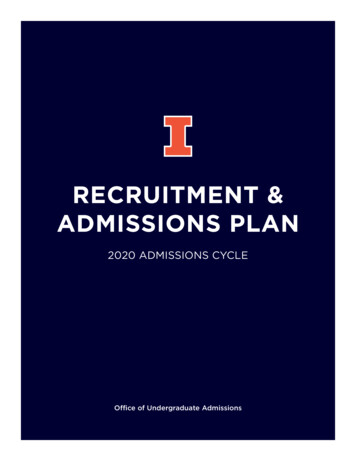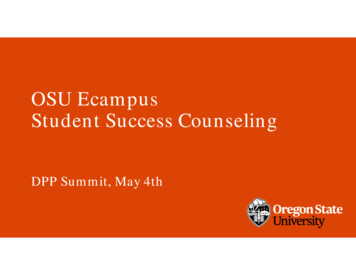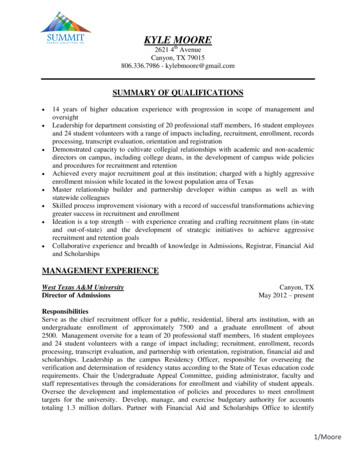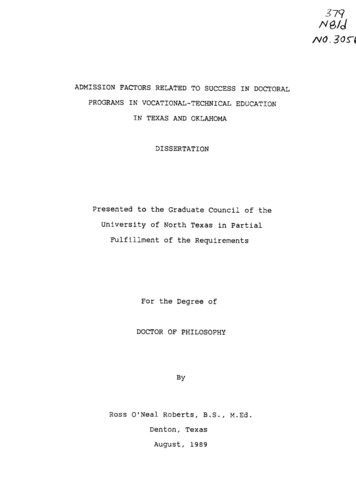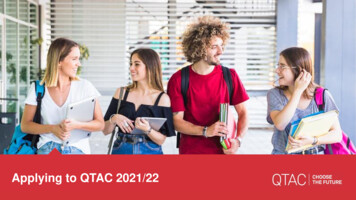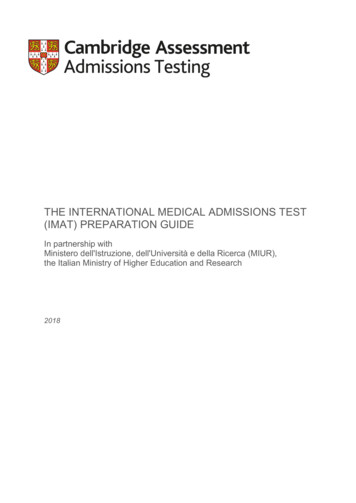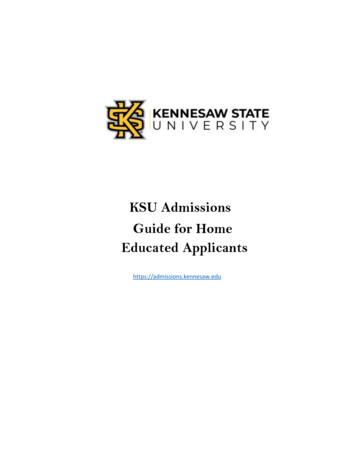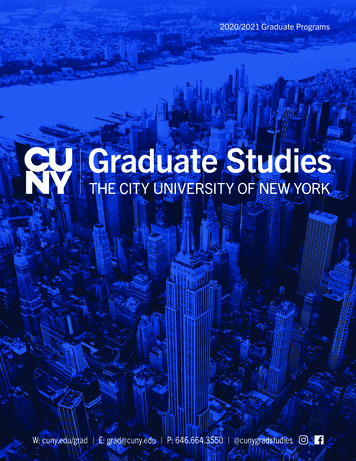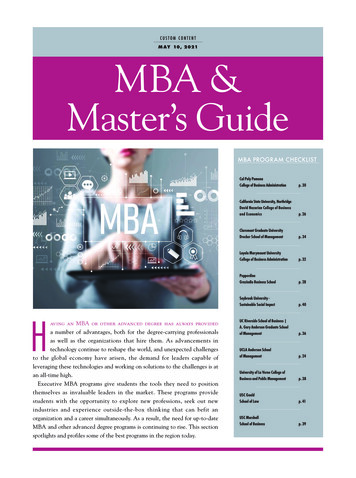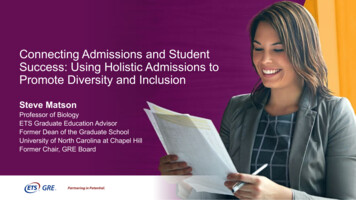
Transcription
Connecting Admissions and StudentSuccess: Using Holistic Admissions toPromote Diversity and InclusionSteve MatsonProfessor of BiologyETS Graduate Education AdvisorFormer Dean of the Graduate SchoolUniversity of North Carolina at Chapel HillFormer Chair, GRE Board
Today’s Discussion Provide a more comprehensive definition of holistic admissions Describe ETS research efforts to understand graduateadmissions practices and curate “Promising Practices” forholistic file review Share experiences from recent UNC Chapel Hill efforts todiversify graduate programs Address misconceptions regarding GRE test Introduce the Office for Graduate Education EngagementCopyright 2020 by Educational Testing Service. All rights reserved. ETS, the ETS logo, MEASURINGTHE POWER OF LEARNING and GRE are registered trademarks of Educational Testing Service (ETS).2
ETSETS ResearchResearch into Graduate Admissions PracticesCampus visits71 interviews with deans and faculty inthe following disciplines: Life sciences Physicalsciences Engineering Social sciences Arts & humanities Education BusinessLiterature reviewExamined published works related tograduate admissions from early 1950sto presentPublished admissions.org/
Information typically considered inholistic reviewWhat is “holistic admissions”?At its core, holistic admissions is about considering all informationto get the fullest picture of everything that an applicant can bring toa program. Undergraduate record, including grades,transcript and reputation of undergraduateprogram Standardized test scores that provideevidence of graduate readiness, such asGRE scores, and English-languageproficiency (as needed), such as TOEFL scores Recommendations Personal statement or statement of purpose Internship and work experience Research experience Demographics, such as gender andethnicityBut it’s not just about what information is considered, but how.Programs that are advanced in their holistic admissions practicetypically: Avoid using threshold (or cutoff) scores that are determined usingonly undergraduate GPA and GRE scores, as that may preventcandidates with other desirable qualities from being considered.Give thought to the weighting of various components of theapplication — and the order in which those components arereviewed — to consider all information about an applicant in a fairand equitable way.4
Overtaxedfaculty & staffLack of ulspendingAnother goal of ETS’sresearch was to provide“Promising Practices”that respect commonchallenges andconstraints
Promising Practices for Holistic Admissions6
Promising PracticeWork together to setgoals and strategies toachieve them Agree upon goals early andstructure admissions process(recruitment to enrollment) toachieve them Be explicit about plans to identifyand recruit desired populationsand how to assess desiredattributes Determine the role andimportance of each componentof an applicant’s file
Ensure agreement on: Enrollment goals, strategy andprocess How to evaluate each componentof the application̶ Role and importance̶ Order of review̶ What inferences can be made How to mitigate unconscious bias How disagreements will beresolvedPromising PracticeDetermine andcommunicate theapplication review andselection process so alldecision makersunderstand
Promising PracticeReview multiplecomponents — evenwhen narrowing the pool— and don’t over rely onany one component If using score guidelines, addanother component Quantify traditionally qualitativecomponents Align rubric weighting to goals Review components in order ofpriority based upon enrollmentgoals Consider an alternative reviewprocess
“Navigating Holistic Admissions” digital guideThis robust resource provides research-based guidance, examples from programs, and downloadable content thatcan be emailed, printed and shared.Resource: Navigating Holistic Admissions Digital GuideAt-a-Glance InfographicGuide PDFPowerPoint with Talking Points10
Holisticadmissions.org/beinformed Answers questions about validity, bias, how to mitigate group score differences, and diversity that members ofthe graduate community are asking themselves, or hearing on campus or within their other academic networks. Contains an FAQ section, a presentation deck and a narrative document that provide information to help informcampus conversations.
Practical Experiences from UNC Chapel Hill12
UNC: Program Completion Is the Goal Changing the admissions process Nursing programs waive the GRErequirement Biological and Biomedical Sciencesprogram moves to holistic review Retention initiatives Training Initiatives in Biomedical &Biological Sciences (TIBBS) Diversity and Student Success (DSS)13
UNC Admissions: Two Case StudiesNursing programs – DNP, PhD, MSN Requested GRE requirement waiver Intended goal: increase diversity Realized impacts Initial increase in applications Slightly higher UGPA for matriculated students No significant increase in diversity in applicant pool14
UNC Admissions: Two Case StudiesBiological and Biomedical Sciences Extensive data set used to look for correlation with ‘success’ 1200-1500 applicants per year No single component predicts success, completion orproductivity Admission process is imperfect – how can it be improved? Need to spend as much time discussing how to supportstudents15
UNC Admissions: Two Case StudiesBiological and Biomedical Sciences Measure productivity in terms of paperspublished 3 1st author; 1-2 1st author; 0 1stauthor with middle author; 0 papers GRE scores did not predict productivity UGPA did not predict productivity Duration of previous research experience didnot predict productivity Recommendation ratings were most reliableHall et. al. PLoS ONE 12(1):e016912116
Adopt a Holistic Admissions Approach We all want good students Educate faculty about non-predictivemeasures of productivity Use these factors in admission decisionsappropriately Educate all admission committee membersabout implicit bias Remove GPA and GRE scores from studentdossier provided to interviewers17
Holistic Admissions Approach Impact Admission committee training adopted in2014 (for fall 2015 admission season) Admission of URM students at 15% (2011-14) Admission immediately rose to 26% Has increased to above 30% with 2019cycle Retention/completion of URM students isidentical with majority students18
Recommendations for File Review Do not assign undue predictive power to UGPA or GRE scores Consider relevant experience particularly when coupled with enthusiasticsupport letters Define criteria for admission in advance Train committees on implicit bias Consider ways to assess non-cognitive qualifications Motivation Perseverance Adaptability Read every application and the entire application — this can be done at scale19
Recommendations for Retention Spend as much time and effort training and supporting students BBSP and Training Initiatives in Biomedical and Biological Sciences (TIBBS) Effort is supported by SoM, IMSD grant, BEST Award Office includes seven full time staff Focused on Admissions Professional Development Internships Career advising Impact: Retention of under-represented students same as majority students(85-92%)20
Common Misconceptions Regarding the GRE Test Predicting Success Cost Fairness21
The GRE General Test Is a Valid Predictor of Many Graduate OutcomesSome reports claiming the test is not predictive of completionhave made headlines in the past year, however, use caution whenconsidering that research for three main reasons: Some of the research has used small sample sizes, which canlead to incorrect conclusions. Some of the research has based conclusions on a restrictedrange of GRE test takers – those who have already beenadmitted.Resources That Can Help A National Center for EducationStatistics report that shows whygraduate students drop out (see p42) A large body of research conductedby external and internal researchersis posted on the GRE Researchwebpage Graduate students generally drop out due to changes in lifecircumstances or other person reasons, which a measure ofacademic skills cannot predict. Many studies lack a true control. Multiple variables are beingchanged at the same time.22
The GRE General Test Is a Valid Predictor of Many Graduate OutcomesIndependent research (a meta-analysis of 1753 samples and a pool of82,659 students by Nathan Kuncel at University of Minnesota) hasshown that: The test is a valid predictor of first-year graduate GPA, overallgraduate GPA, comprehensive exam scores, publication citationcounts and faculty ratings. The test correlates positively with degree attainment and researchproductivity. The test has better predictive validity than undergraduate gradesor letters of recommendation.Resources That Can Help The Validity of the Graduate RecordExamination for Master’s andDoctoral Programs: A Meta-analyticInvestigation In addition to the seminal reportdescribed at left, a large body ofresearch conducted by external andinternal researchers is posted on theGRE validity resources webpage andGRE research webpage. All of the above results apply across a range of intended academicmajors, across native speakers of English and nonnative speakersof English, and across master’s and doctoral programs.23
ETS Offers Resources So Cost Is Not a Barrier The fee is required to offer the exam in test centers around theworld on a continuous basis, for human raters to read and score allessay responses, for test security, and to offer accommodations fortest takers with disabilities. To defray the cost, ETS:— makes available excellent, free test prep to all— offers a Fee Reduction Program, which reduces the cost by halffor those with financial need and to national programs thatserve students from underrepresented groups, first-generationcollege students, and students with financial need. Individualswho qualify for a fee reduction also get free access toadditional test prep valued at 100.Resources That Can Help GRE Fee Reduction Programwebpage GRE Test Prep webpage Advisor Toolkit, which includesinformation about testpreparation workshops forcampus educators and theprepaid voucher service As a nonprofit organization, ETS reinvests any revenue earned overexpenses in research that addresses big educational challenges.24
There are three ways forapplicants to pay less —or nothing — to take theGRE General Test and/ora GRE Subject Test1)Apply for a 50% fee reduction voucher,which is available for individuals who candemonstrate financial need2)Receive a 50% fee reduction voucherfrom one of a dozen programs that servestudents from underrepresented groups,first-generation college students, andstudents with financial need3)Receive a full or partial pre-paidvoucher from any sponsoring program,organization or individual.To learn about fee reduction: www.ets.org/gre/grefeereductionTo learn about pre-paid paid voucher25
NEW!NEW!NEW! NEW! NEW! Business Leaders of TomorrowGates Millennium Scholars ProgramInstitute for Recruitment of Teachers (IRT)Louis Stokes Alliances for Minority Participation(LSAMP)Maximizing Access to Research Careers (MARC)Undergraduate Student Training in AcademicResearch (U-STAR) ProgramNational Consortium for Graduate Degrees forMinorities in Engineering and Science Program (GEM)Postbaccalaureate Research Education Program(PREP)Research Initiative for Scientific Enhancement (RISE)ProgramSociety for the Advancement of Chicanos and NativeAmericans in Science (SACNAS)TheDream.USTRIO Ronald E. McNair PostbaccalaureateAchievement ProgramTRIO Student Support Services (SSS) ProgramNew this year: Five additional programswill receive 50% feereduction vouchers,bringing the total to 12 Vouchers available for thefirst time to internationalstudents through theEducationUSA OpportunityFund ProgramLearn more at www.ets.org/gre/grefeereduction26
POWERPREP PLUS Online Practice TestsThis set of practice tests is the closestsimulation to what a test taker will actuallyencounter on test day. Test takers can: understand what's being tested gain familiarity with question types and thefunctionality of the test practice taking the test under timed conditionsAlso new this year: Individuals who qualify fora fee reduction also getfree access to additionaltest prep valued at 100. Try out the following accommodations for test takerswith disabilities or health-related needs: extended time,extra breaks, screen magnification, selectable colors,and screen reader and refreshable braille compatibility.ScoreItNow! Online Writing PracticeThis online tool enables test takers to sharpen their writingskills as they prepare for the Analytical Writing measure ofthe GRE General Test. Students can write and submitresponses to two essay topics and get immediate scores andfeedback.Learn more at www.ets.org/gre/grefeereduction27
The Test Undergoes a Rigorous Process to Eliminate Bias to the Extent Possible Group performance differences are related to disparities in educationalopportunities over a long period of time. If people are exposed todifferent opportunities and educational experiences, how can we expectthem to perform the same on a test? No other piece of the application endures the samerigorous fairness process as the GRE General Test, which include:— Training staff on the ETS Standards for Quality and Fairness,which are aligned with AERA/NCME/APA professional standards— Forming diverse teams to review test questionsResources That Can Help ETS Standards for Quality andFairness ETS's Life of An Item video The GRE Guide to the Use ofScores (p14)— Removing questions from tests that seem to disadvantage anyone group The “Diversity, Equity & Inclusion” committee of the GRE Board advisesthe GRE Program on fairness related to research and services28
The GRE Test is the Single Common Objective Measure Across All Applications All components of the application are subject to bias; only the GREtest has checks and balances to ensure it is as fair and unbiased aspossible Remember:— Educational opportunities and life circumstances may have asubstantial influence on all components of an application.— Letters of recommendation may reflect bias.— Graduating from an elite institution may reflect anapplicant’s socioeconomic background rather than theapplicant’s intellectual, scholarly, or creative potential.— Graduates from elite institutions are likely to have had moreopportunities for research and creative experience thangraduates from other institutions.— Without GRE scores, students who attended lesser-knowninstitutions are less able to demonstrate their academiccapabilities.Resources That Can Help Four Facts Aboutthe GRE General Test ReviewerDiligence andResponsibility inthe GraduateApplicationProcess29
New research provides a blueprint for holisticreview using GRE scoresA 2019 report by Marenda Wilson and other researchers at The University of Texas MDAnderson Cancer Center UTHealth Graduate School of Biomedical Sciences concludedthat:It is the practice of using cut scores, not the GRE test itself, that disproportionatelyaffects doctoral applicants from underrepresented groupsAn admissions committee can mitigate GRE score variances between demographicgroupsA multitiered holistic applicant review process can increase the diversity of the applicantpool without increasing the workload of the admissions committeeThe report also provides a blueprint for institutions that want to implement a data-drivenapproach to assess applicants in a manner that uses GRE scores as part of the process.Resource: A Model for Holistic Review in Graduate Admissions That Decouples the GREfrom Race, Ethnicity, and Gender
Office for Graduate Education EngagementTerry AckermanDistinguished Professor ofEducational Measurement atUniversity of IowaJohn AugustoAssociate Dean of StrategicInitiatives at Georgia StateUniversityMaureen GrassoProfessor of Textile Sciencesand Former Graduate Deanat North Carolina StateUniversity and FormerGraduate Dean at Universityof GeorgiaCarlos GrijalvaEmeritus Professor ofPsychology andNeuroscience and FormerGraduate Associate Deanat the University ofCalifornia, Los AngelesSteve MatsonBiology Professor andFormer Graduate Dean atUniversity of NorthCarolina at Chapel Hill31
GRE General Test Is a Valid Predictor of Many Graduate Outcomes Independent research (a meta-analysis of 1753 samples and a pool of 82,659 students by Nathan Kuncel at University of Minnesota) has shown that: The test is a valid predictor of first-year graduate GPA, overall graduate GPA, comprehensive exam scores, publication citation
